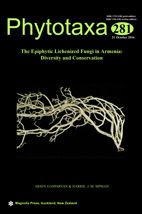Abstract
A total of 230 taxa of lichenized fungi are reported from epiphytic habitats in Armenia based on field studies from 2011 to 2015 and evaluation of the available literature. For each species, notes on taxonomy, chemistry, ecology, and local, regional and world distribution are presented, as well as presence in the protected areas of the country. An identification key for all species is added. Of the total, 219 are specialized epiphytes, rarely found on other substrates, while 11 species occur only incidentally on bark and more usually on rock. The epiphytic lichenized fungi of Armenia belong to 13 orders, 34 families and 88 genera. The most species-rich higher taxa are Lecanorales (Parmeliaceae, Physciaceae, Teloschistaceae), Arthoniales, Peltigerales and Pertusariales. Lecanora, Usnea and Phaeophyscia are the most species-rich genera. The following 28 taxa are new records for Armenia: Arthonia atra, Bacidia biatorina, Bacidina adastra, Biatora longispora, Bryoria fuscescens, Bryostigma muscigenum, Buellia erubescens, Candelariella efflorescens, Flavoparmelia soredians, Hypocenomyce scalaris, Lecidella cf. pulveracea, Lepraria jackii, Lepraria leuckertiana, Leptogium cyanescens, Ochrolechia pallescens, Pertusaria slesvicensis, Phaeophyscia endophoenicea, Phlyctis agelaea, Phlyctis argena, Placynthiella icmalea, Pyrrhospora quernea, Ramalina panizzei, Rinodina griseosoralifera, Rinodina polysporoides, Strigula stigmatella, Varicellaria hemisphaerica. Four genera are for the first time reported for the country, Hypocenomyce, Phlyctis, Pyrrhospora and Strigula. 188 species (82% of the epiphytic lichen mycobiota) were found in the Specially Protected Nature Areas of Armenia. The conservation status of 74 species has been evaluated following the IUCN Red List of Threatened Species categories and criteria. Among them we assessed 9 taxa as Critically Endangered, 5 taxa as Endangered, 2 taxa as Vulnerable, 4 taxa as Data Deficient and 54 taxa as Least Concern. Epiphytic lichens reported from Armenia showed predominantly holarctic distributional patterns. 187 species were found in the temperate deciduous and mixed forests, which dominate in Northern and Central Armenia, and 56 species in the open arid woodlands of Southern Armenia.

